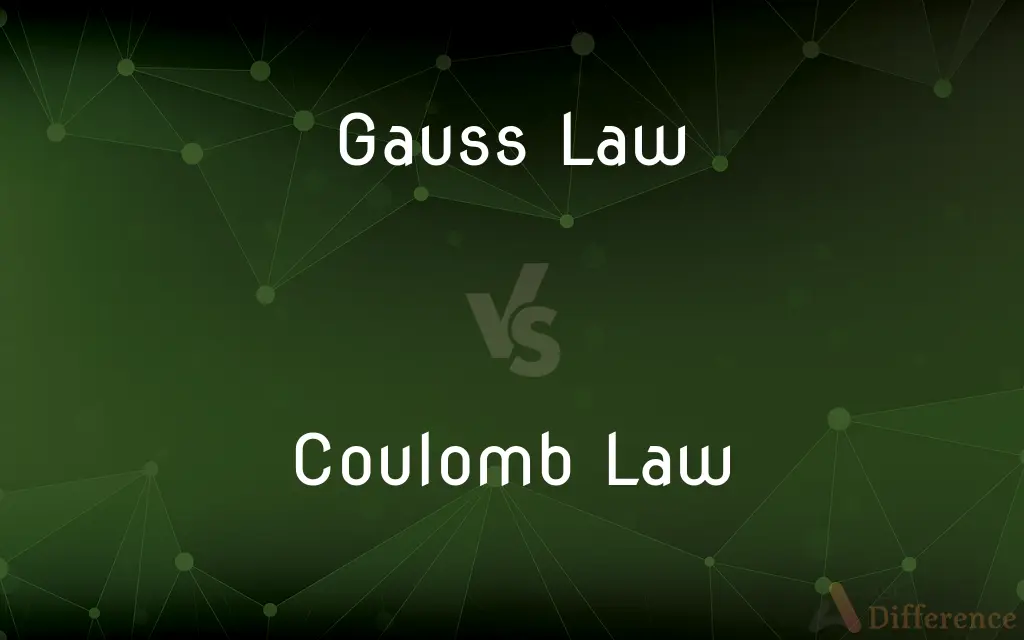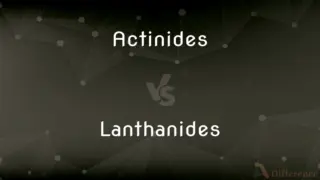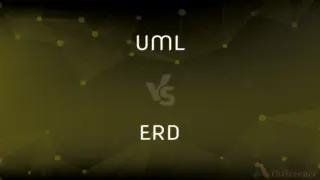Gauss Law vs. Coulomb Law — What's the Difference?
By Tayyaba Rehman — Published on December 24, 2023
Gauss's Law relates electric flux through a closed surface to the charge enclosed by it, while Coulomb's Law describes the electrostatic force between two charged particles. Different forms, but equivalent in electrostatics.

Difference Between Gauss Law and Coulomb Law
Table of Contents
ADVERTISEMENT
Key Differences
Gauss's Law, expressed mathematically as ∮E • dA = Q/ε₀, where E is the electric field, dA is the area element, Q is the charge enclosed, and ε₀ is the permittivity of free space, provides a relationship between an electric field and the charge that produces it. On the other hand, Coulomb’s Law, F = k * |q₁q₂|/r², elucidates the force between two charges, q₁ and q₂, separated by a distance r, with k being Coulomb's constant.
Gauss’s Law is incredibly useful in determining the electric field in situations with high symmetry, where the electric field’s magnitude is either constant or zero over a closed Gaussian surface. Coulomb's Law, on the contrary, predominantly describes the interaction between two point charges and is used as a fundamental basis for understanding electrostatic interactions.
When considering applications, Gauss’s Law shines in scenarios with continuous charge distributions due to its formulation, which allows the simplification of complex integrals in symmetric situations. Meanwhile, Coulomb’s Law finds its utility in analyzing forces and potentials arising from point charges, fundamental in understanding basic electrostatic interactions.
A vital distinction lies in the methodologies of the laws; Gauss’s Law employs a conceptual approach, relying on symmetrical configurations to deduce electric fields without handling individual charge interactions. Coulomb’s Law, though fundamental, might be computationally intensive when addressing numerous individual charge interactions due to its point-charge focused approach.
Despite differences, Gauss's Law and Coulomb’s Law are inherently connected; Gauss's Law can be derived from Coulomb’s Law, and both are instrumental in describing the fundamental nature of electrostatic interactions, serving as pivotal concepts in electromagnetic theory.
ADVERTISEMENT
Comparison Chart
Main Variable of Interest
Electric field (E)
Force (F)
Primary Use
Dealing with symmetric charge distributions
Describing force between point charges
Mathematical Formulation
Integral form
An inverse square law
Application Scope
Applicable in high symmetry
Applicable for any pair of point charges
Computational Aspect
Simplifies calculations in symmetric setups
Can be computationally intensive for multiple charges
Compare with Definitions
Gauss Law
Utilizes symmetric properties of charge distributions for simplifying calculations.
Gauss’s Law aids in calculating the electric field due to a uniformly charged cylinder without direct integration.
Coulomb Law
Constitutes a fundamental law in electrostatics.
Coulomb’s Law, foundational in physics, explains how charged particles in an atom interact.
Gauss Law
Relates the electric field around a closed surface to the enclosed charge.
Using Gauss's Law, the electric field due to a charged sphere can be easily determined.
Coulomb Law
Has universal applicability for any pair of point charges.
Coulomb’s Law can depict the force between two charges regardless of the medium between them.
Gauss Law
Can be derived from Coulomb’s Law.
Gauss's Law, foundational in electromagnetism, is consistent with the principles laid down by Coulomb’s Law.
Coulomb Law
Describes the electrostatic force between two point charges.
Coulomb’s Law helps calculate the force between two electrons in a hydrogen molecule.
Gauss Law
Allows consideration of electric fields due to continuous charge distributions.
Gauss’s Law enables scientists to ascertain the electric field emanating from a charged plane.
Coulomb Law
Can be used to derive Gauss's Law in certain conditions.
Through mathematical manipulations, Coulomb’s Law can be employed to derive Gauss's Law.
Gauss Law
Employs the concept of an electric flux linked with enclosed electric charge.
The electric flux through a Gaussian surface is directly proportional to the enclosed charge, as per Gauss's Law.
Coulomb Law
Implements the inverse square law in its formulation.
The electrostatic force increases significantly as charged particles move closer, according to Coulomb’s Law.
Common Curiosities
What is the key relationship defined by Gauss’s Law?
Gauss’s Law relates electric flux through a closed surface to the charge enclosed by it.
Can Coulomb’s Law handle interactions between multiple charges?
Yes, but it requires the superposition principle to evaluate multiple pairwise interactions, which can be computationally intensive.
Is Gauss’s Law applicable to any charge configuration?
No, Gauss's Law is most effectively applied in situations involving a high degree of symmetry in charge configurations.
What does electric flux represent in Gauss’s Law?
It represents how much electric field penetrates through a given area.
How is the direction of force determined in Coulomb’s Law?
The force is attractive if the charges are opposite, and repulsive if they are alike.
How does Coulomb’s Law describe force between charges?
Coulomb’s Law describes it as a product of the charges and inversely proportional to the square of their separation.
When is Gauss’s Law especially useful?
Gauss’s Law is notably beneficial when dealing with problems involving symmetric charge distributions.
Can Gauss’s Law be applied in non-vacuum mediums?
Yes, the permittivity ϵ in Gauss's Law may be adapted for different mediums.
Can Gauss’s Law determine electric fields due to non-enclosed charges?
No, Gauss's Law explicitly relates enclosed charge to electric flux through a surface.
Is it possible to derive Coulomb’s Law from Gauss’s Law?
No, Coulomb's Law is more fundamental and Gauss's Law can be derived from it under certain assumptions.
Can Coulomb’s Law predict forces in a charged medium?
Yes, but the material properties must be accounted for, typically through a material’s permittivity.
Does Gauss’s Law hold in dynamic electromagnetic fields?
Gauss’s Law for electricity holds even in dynamic conditions, but modifications (i.e., in Maxwell's equations) might be needed.
How is the electrostatic force vector obtained from Coulomb’s Law?
It’s along the line connecting the two charges, with direction defined by the nature (sign) of the charges.
Are Coulomb’s Law and Newton’s Law of Gravitation similar?
They share an inverse-square relationship form, but differ in fundamental aspects like force mediators and applicable entities.
Share Your Discovery

Previous Comparison
Actinides vs. Lanthanides
Next Comparison
UML vs. ERDAuthor Spotlight
Written by
Tayyaba RehmanTayyaba Rehman is a distinguished writer, currently serving as a primary contributor to askdifference.com. As a researcher in semantics and etymology, Tayyaba's passion for the complexity of languages and their distinctions has found a perfect home on the platform. Tayyaba delves into the intricacies of language, distinguishing between commonly confused words and phrases, thereby providing clarity for readers worldwide.












































